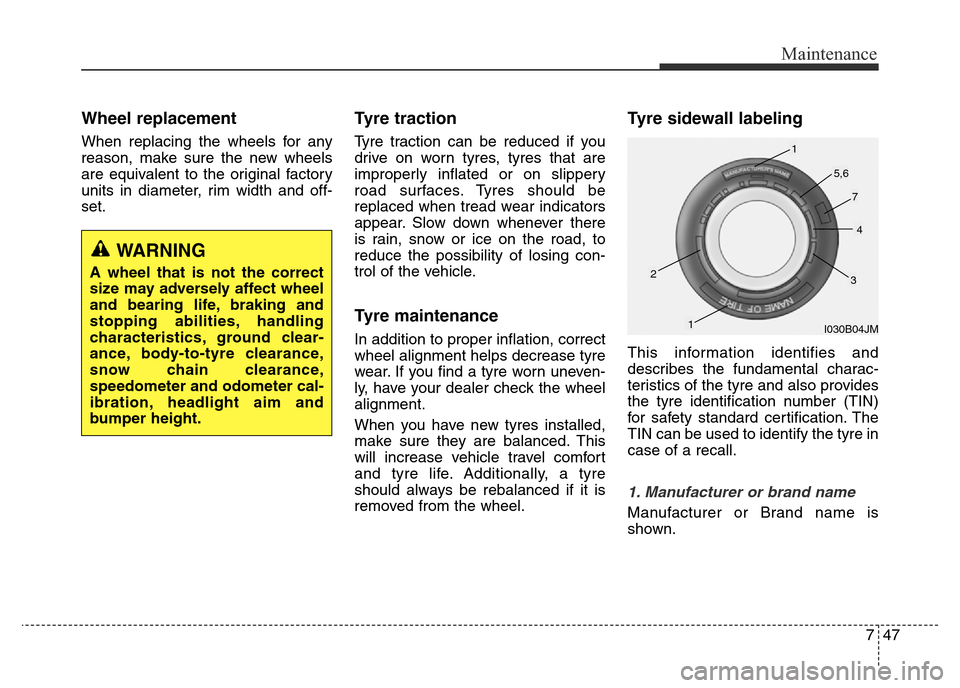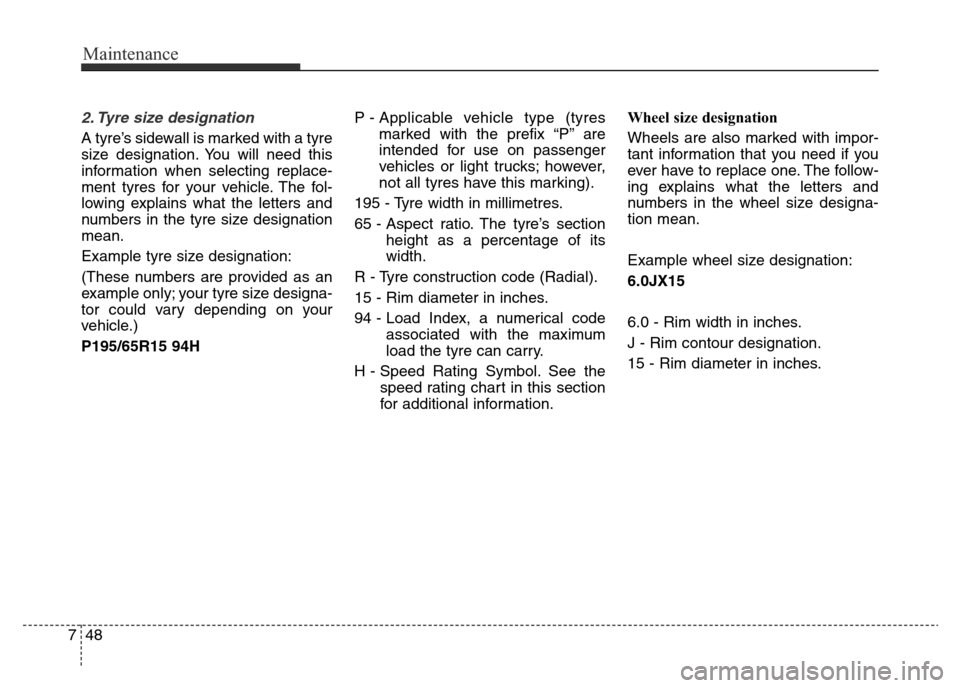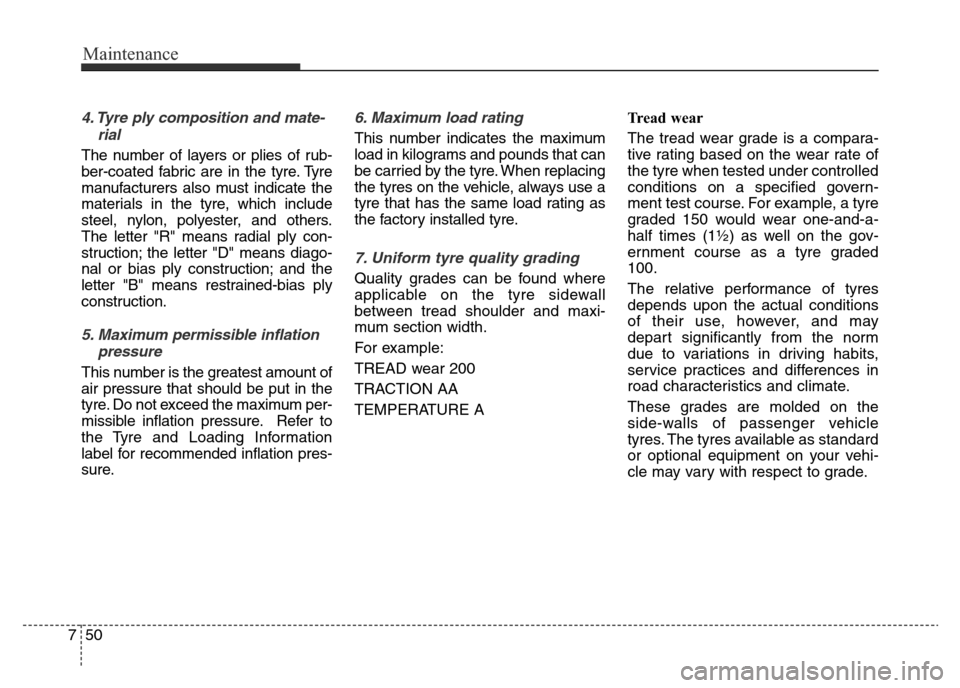Page 442 of 498

747
Maintenance
Wheel replacement
When replacing the wheels for any
reason, make sure the new wheels
are equivalent to the original factory
units in diameter, rim width and off-
set.
Tyre traction
Tyre traction can be reduced if you
drive on worn tyres, tyres that are
improperly inflated or on slippery
road surfaces. Tyres should be
replaced when tread wear indicators
appear. Slow down whenever there
is rain, snow or ice on the road, to
reduce the possibility of losing con-
trol of the vehicle.
Tyre maintenance
In addition to proper inflation, correct
wheel alignment helps decrease tyre
wear. If you find a tyre worn uneven-
ly, have your dealer check the wheel
alignment.
When you have new tyres installed,
make sure they are balanced. This
will increase vehicle travel comfort
and tyre life. Additionally, a tyre
should always be rebalanced if it is
removed from the wheel.
Tyre sidewall labeling
This information identifies and
describes the fundamental charac-
teristics of the tyre and also provides
the tyre identification number (TIN)
for safety standard certification. The
TIN can be used to identify the tyre in
case of a recall.
1. Manufacturer or brand name
Manufacturer or Brand name is
shown.
WARNING
A wheel that is not the correct
size may adversely affect wheel
and bearing life, braking and
stopping abilities, handling
characteristics, ground clear-
ance, body-to-tyre clearance,
snow chain clearance,
speedometer and odometer cal-
ibration, headlight aim and
bumper height.
I030B04JM
1
1
23
4
5,6
7
Page 443 of 498

Maintenance
48 7
2. Tyre size designation
A tyre’s sidewall is marked with a tyre
size designation. You will need this
information when selecting replace-
ment tyres for your vehicle. The fol-
lowing explains what the letters and
numbers in the tyre size designation
mean.
Example tyre size designation:
(These numbers are provided as an
example only; your tyre size designa-
tor could vary depending on your
vehicle.)
P195/65R15 94HP - Applicable vehicle type (tyres
marked with the prefix “P’’ are
intended for use on passenger
vehicles or light trucks; however,
not all tyres have this marking).
195 - Tyre width in millimetres.
65 - Aspect ratio. The tyre’s section
height as a percentage of its
width.
R - Tyre construction code (Radial).
15 - Rim diameter in inches.
94 - Load Index, a numerical code
associated with the maximum
load the tyre can carry.
H - Speed Rating Symbol. See the
speed rating chart in this section
for additional information.Wheel size designation
Wheels are also marked with impor-
tant information that you need if you
ever have to replace one. The follow-
ing explains what the letters and
numbers in the wheel size designa-
tion mean.
Example wheel size designation:
6.0JX15
6.0 - Rim width in inches.
J - Rim contour designation.
15 - Rim diameter in inches.
Page 445 of 498

Maintenance
50 7
4. Tyre ply composition and mate-
rial
The number of layers or plies of rub-
ber-coated fabric are in the tyre. Tyre
manufacturers also must indicate the
materials in the tyre, which include
steel, nylon, polyester, and others.
The letter "R" means radial ply con-
struction; the letter "D" means diago-
nal or bias ply construction; and the
letter "B" means restrained-bias ply
construction.
5. Maximum permissible inflation
pressure
This number is the greatest amount of
air pressure that should be put in the
tyre. Do not exceed the maximum per-
missible inflation pressure. Refer to
the Tyre and Loading Information
label for recommended inflation pres-
sure.
6. Maximum load rating
This number indicates the maximum
load in kilograms and pounds that can
be carried by the tyre. When replacing
the tyres on the vehicle, always use a
tyre that has the same load rating as
the factory installed tyre.
7. Uniform tyre quality grading
Quality grades can be found where
applicable on the tyre sidewall
between tread shoulder and maxi-
mum section width.
For example:
TREAD wear 200
TRACTION AA
TEMPERATURE ATread wear
The tread wear grade is a compara-
tive rating based on the wear rate of
the tyre when tested under controlled
conditions on a specified govern-
ment test course. For example, a tyre
graded 150 would wear one-and-a-
half times (1½) as well on the gov-
ernment course as a tyre graded
100.
The relative performance of tyres
depends upon the actual conditions
of their use, however, and may
depart significantly from the norm
due to variations in driving habits,
service practices and differences in
road characteristics and climate.
These grades are molded on the
side-walls of passenger vehicle
tyres. The tyres available as standard
or optional equipment on your vehi-
cle may vary with respect to grade.
Page 491 of 498
Specifications & Consumer information
2 8
ENGINE
DIMENSIONS
Item Petrol 1.8
Displacement
cc1,797
Bore x Stroke
mm81x87.2
Firing order 1-3-4-2
No. of cylinders 4, In-line
Item mm
Overall length 4550
Overall width 1775
Overall height 1435
Front tread 1563 *
1/ 1549 *2 / 1551 *3
Rear tread1576 *1/ 1562 *2 / 1564 *3
Wheelbase2700
*1: with R15 tyre
*
2: with R16 tyre
*
3: with R17 tyre
AIR CONDITIONING SYSTEM
ItemWeight of volume Classification
Refrigerant
500g R134a
Compressor lubricant
100g FD46XG